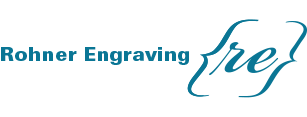What we do
Engraving
Engraving is a method of creating raised areas of print or images on paper, such as a business card or letterhead. An impression is created on a metal plate, which is then filled with opaque ink. When paper is pressed into the plate, it creates raised and colored areas.
When you want your message to be felt as well as seen, engrave it. The raised image adds tactile interest and rich, opaque color. Engraved type is the most legible of all processes. And engraving always communicates a message of solidity and sophistication.
Offset Lithography
Offset lithography or “flat printing”, works by first transferring an image photographically to thin metal, paper, or plastic printing plates. Unlike other forms of printing, in offset lithography the image on the printing plate is not recessed (like engraving) or raised (like letterpress).
Rollers apply oil-based ink and water to the plates. Since oil and water don’t mix, the oil-based ink won’t adhere to the non-image areas. Only the inked image portion is then transferred to a rubber blanket that then transfers the image onto the paper as it passes between it and another cylinder beneath the paper.
The term offset refers to the fact that the image isn’t printed directly to the paper from the plates, but is offset or transferred to rubber blanket that then makes contact with the paper.
Thermography
Thermographic or “raised printing”, is the same process as offset lithography. Additionally, in thermography, a special powder is added to the document with it adhering to the wet ink printed on the paper. After removing the excess powder the printed piece is heated and the powder and ink mixture dries to form a raised effect on the paper.
Embossing
To create a three-dimensional design or image, choose embossing. In embossing, heat and pressure combine to reshape the surface of the paper to create the image. There are several different styles of embossing:
Single level — A single level emboss is exactly what the name implies. The area being embossed is raised above the surface one level.
Multi-level — Most often used for illustrations where detail is needed, a multi-level emboss adds extra dimension.
Beveled — This style of single-level embossing features beveled, rather than straight, edges.
Sculptured — For a sculptured emboss the area being raised is more of a contour and there is not one distinct level.
Embossing may be done “blind” (with just the color of the paper showing through) or “registered” (where the image is first printed and then embossed.) Registered embossing can also be used in conjunction with foil-stamping.??In Debossing, the image is pressed into the paper, creating a depression rather than a raised impression, as in embossing. Like embossing, debossing can also be used blind or used with foil and inks. Both of these processes are especially suited for stationery, business cards, invitations, book cover and folders.
Foil Stamping
Foil stamping, is the application of pigment or metallic foil, often gold or silver , but can also be various patterns or what is known as pastel foil which is a flat opaque color or white special film-backed material, to paper where a heated die is stamped onto the foil, making it adhere to the surface leaving the design of the die on the paper. Foil stamping can be combined with embossing to create a more striking 3D image.
Die Cutting
Die cutting is not just for pocket folders anymore. With our in-house die cutting equipment, we can produce interesting shapes and clever “see-throughs.” If you’re looking to add an interesting twist to your project, consider die cutting.
Letterpress
Letterpress printing was the normal form of printing text from its invention by Johannes Gutenberg in the mid-15th century until the 19th century and remained in wide use for books and other uses until the second half of the 20th century. Letterpress printing remained the primary way to print and distribute information until the twentieth century, when offset printing was developed, which largely supplanted its role in printing books and newspapers. More recently, letterpress printing has seen a revival in an artisanal form.
Edge Painting
Edge painting has a rich history in engraving—for centuries, master bookbinders gilded the edges of books with gold, to show a preciousness. So now this modern spin: we hand-paint the outside edges of our paper to highlight an existing color in the design or to introduce an entirely new color. Edging is most striking in medium to dark colors.
Custom Finishing
We have the capability to add a variety of finishing touches. In addition to edge painting, we can do beveling, drilling, perforating, envelope converting and lining, scoring, folding, intricate handwork like ribbon typing, etc.
